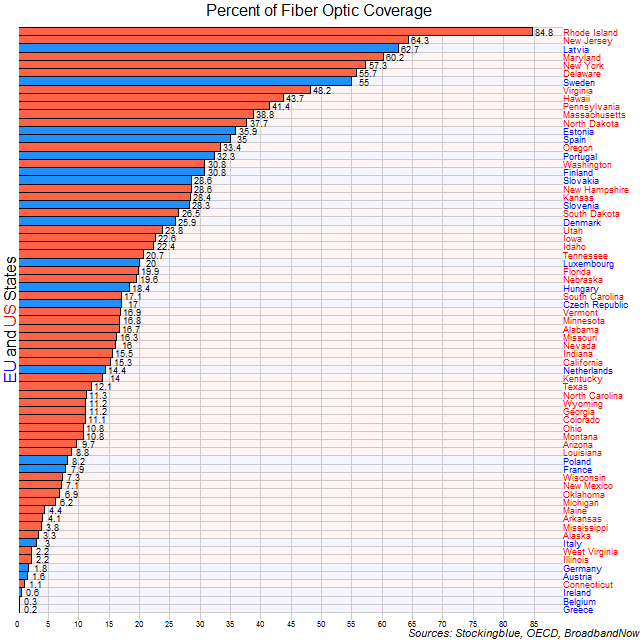
Most states in both the United States and the European Union are slow to pick up on fiber usage with only seven states from both superstates covering over half of their population. Ten of the top 12 states where fiber is most accessible are from the US.
Findings
- Generally speaking, the northeastern United States has the best coverage (excluding Connecticut and Maine).
- In Europe, the best coverage is in the Baltics, Nordic countries, and the Iberian peninsula.
- Most states cover less than one-fifth of their population.
- A large swath of states cover less than one-tenth of their population.
- Six out of the nine states with the least coverage are in the EU.
Caveats
- The data for the United States and the European Union comes from two different sources who may have different methodologies for collecting the data.
- Bulgaria, Croatia, Cyprus, Lithuania, Malta, Romania, and the United Kingdom were missing data.
Details
Out of the 71 states included in the study, only Rhode Island covers more than two-thirds of its population, and only Rhode Island, New Jersey, Latvia, Maryland, New York, Delaware, and Sweden cover over half of their population.
Three states cover less than one percent of their population: Greece, Belgium, and Ireland. Less than five percent is covered in the above states as well as Connecticut, Austria, Germany, Illinois, West Virginia, Italy, Alaska, Mississippi, Arkansas, and Maine.
Some of these states have valid excuses as their residents live in remote areas, namely Alaska and Maine. However, most of the states with the least coverage have densely packed populations in small urban areas. One of the least densely populated states with a large area, North Dakota, has managed to cover over one-third of its population. This may have something to do with the oil boom in the state, but South Dakota which has similar characteristics in area and population has also covered one-fourth of its population without an oil boom.
Economic wealth does not seem to be a factor as wealthy and poor states can be found to have either good or poor coverage.
Sources
BroadbandNow. 2017. "Fiber-Optic Internet In the United States at a Glance." Accessed October 24, 2017. https://broadbandnow.com/Fiber
The Organisation for Economic Cooperation and Development. 2017. "OECD Broadband Portal." Accessed October 24, 2017. http://www.oecd.org/sti/broadband/oecdbroadbandportal.htm